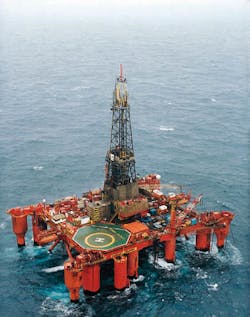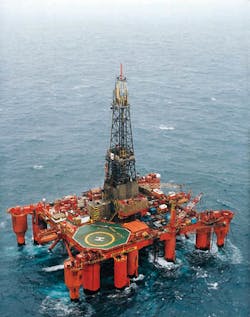Falkland Island consortia begin testing geological models
South Atlantic rig rotation to avoid efforts duplication
The Borgny Dolphin semi, prior to its 70-80 day tow to the South Atlantic.Drilling crews are on their way to the South Atlantic, in readiness for the first well off the Falkland Islands (Malvinas). Weather permitting, the May spud will be achieved just 17 months after the first licenses were awarded for this remote frontier region.
The remoteness actually served to speed up this operation. Rather than going it alone in an area hundreds of miles from established oilfield infrastructure, and with rigs so hard to come by, four of the license holders decided to pool their preparations. This exercise extended to environmental impact assessment, logistics and contracting the rig on a timeshare basis. The rig will drill wells for all four consortia in strict rotation.
To further avoid duplication of efforts, different geological models will be tested, and some of the ensuing well data will be shared too (where commercially co-beneficial).
The chosen semisubmersible is the Borgny Dolphin, an enhanced Aker H3 design which was recently upgraded and re-certified in western Norway for drilling in water depths down to 470 meters-plus. New equipment fitted includes mud pumps, engines, the electrical control system for power generation, cement mixers, and state of the art shale shakers, designed to limit the impact of discharged, water-based mud cuttings.
Casing will be shipped from a Siderca steel mill in Argentina, but everything else will be sourced out of Aberdeen, 7,532 nautical miles from the first well location. Towing of the semi to this site is expected to take up to 80 days, on a route that veers west from the Canary Islands to the east coast of South America, before following the currents southeast to the Falklands.
Other contracts
Lasmo, one of the four license operators, contracted Stanley CSM for logistics support and management services. This is a joint venture of companies based in the UK and the Falklands capital, Port Stanley. Multipurpose vessel Kapitan Vaga will shuttle back and forth between Aberdeen and Port Stanley bearing cranes, containers, wellhead equipment, drilling, and other supplies. Borgny Dolphin is booked for five firm wells over eight months, with options for further drilling if results warrant it.The shipments include a full North Sea spec, 12-seat Bristow helicopter which will fly drilling crews from the nearest point onshore, Cape Dolphin. The site for the launch pad has been acquired from a local farmer, who is also being trained in refueling and maintenance of the aircraft. Up to 90 personnel will work permanently on the rig, on 28-day shifts.
Costs for these arrangements are being borne equally by the four licensed operators that make up the Falklands Offshore Sharing Agreement (FOSA) alliance. Their budget for mobilization of drilling supplies is $25 million, which pushes the overall well costs slightly above an equivalent operation in the Shetland Basin.
Last year, license A operator Amerada Hess contracted the Borgny Dolphin for three years' service at a fixed day rate of $130,000. In view of subsequent price hikes in the North Sea (the rig was previously on hire to Shell UK Expro), this is not a bad deal, according to Amerada operations manager Andy Morrison, but it is also high enough.
Each FOSA operator commissioned environmental screening studies for their licensed tranches and surrounding areas. In addition, they participate in the Falkland Islands Exploration and Production Environmental Forum, along with the islands' government and local conservationists. Greenpeace has not been invited to the talks. Currently, the islands are finalizing an oil spill response contingency plan - important wildlife at risk include rockhopper, gentoo penguin, and lobster krill.
May drilling
Borgny Dolphin is due to drill for Amerada in Tranche A in May and June, before transferring to Lasmo (C & D operator) in July, IPC (F) in September, Shell (B) in November, then back to Amerada in late December. Each well is expected to take 45-60 days, including mooring, running of BOP stacks, casing strings and so on, leaving little margin for timing errors. Further drilling, if required, would resume next March.Results of the seismic surveys shot over the four licensees' tranches suggest that the wells will not be particularly deep or difficult to drill. Amerada's should terminate at 2,750 meters, Morrison reckoned. The drilling program coincides with the onset of the Falklands winter, but recent climate analysis suggests conditions are marginally better then than in the summer. Also, currents appear to be less severe than originally imagined.
Weather downtime is expected to be a little lower than for Shetland area operations. Studies of the Falklands' synrift geology have found parallels with South Africa and South America. Tranches A and B are considered the most prospective; the sedimentary sequence is thickest. Amerada has identified structures of potentially 200-400 million bbl, and also some smaller structures. A 100-million bbl field with good productivity is the minimum requirement for justifying a development based on an FPSO with tanker offloading.
Even in the shallower waters, this is seen as more practical than a fixed platform, which would entail more expensive backup onshore. Harbor areas generally appear limited, although there is one bay that could offer deepwater access.
Copyright 1998 Oil & Gas Journal. All Rights Reserved.

